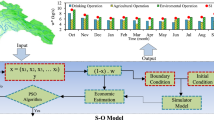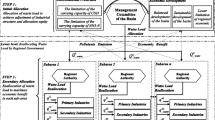Abstract
This research aims to study a novel approach for waste load allocation (WLA) to meet environmental, economical, and equity objectives, simultaneously. For this purpose, based on a simulation-optimization model developed for Haraz River in north of Iran, the waste loads are allocated according to discharge permit market. The non-dominated solutions are initially achieved through multiobjective particle swarm optimization (MOPSO). Here, the violation of environmental standards based on dissolved oxygen (DO) versus biochemical oxidation demand (BOD) removal costs is minimized to find economical total maximum daily loads (TMDLs). This can save 41 % in total abatement costs in comparison with the conventional command and control policy. The BOD discharge permit market then increases the revenues to 45 %. This framework ensures that the environmental limits are fulfilled but the inequity index is rather high (about 4.65). For instance, the discharge permit buyer may not be satisfied about the equity of WLA. Consequently, it is recommended that a third party or institution should be in charge of reallocating the funds. It means that the polluters which gain benefits by unfair discharges should pay taxes (or funds) to compensate the losses of other polluters. This intends to reduce the costs below the required values of the lowest inequity index condition. These compensations of equitable fund allocation (EFA) may help to reduce the dissatisfactions and develop WLA policies. It is concluded that EFA in integration with water quality trading (WQT) is a promising approach to meet the objectives.




Similar content being viewed by others
References
Axelrad, G., & Feinerman, E. (2009). Regional planning of wastewater reuse for irrigation and river rehabilitation. Journal of Agricultural Economics, 60(1), 105–131.
Azadnia, A., & Zahraie, B. (2010). Optimization of nonlinear Muskingum method with variable parameters using multi-objective particle swarm optimization. World environmental and Water Resources Congress, ASCE, 2278-2284, doi: 10.1061/41114(371)235.
Baltar, A. M., & Fontane, D. G. (2008). Use of multi-objective particle swarm optimization in water resource management. Journal of Water Resources Planning and Management, 134(3), 257–265.
Burn, D. H., & Yulianti, J. S. (2001). Waste-load allocation using genetic algorithms. Journal of Water Resources Planning and Management, 127(2), 121–129.
Collentine, D. (2005). Including non-point sources in a water quality trading permit program. Water Science and Technology, 51(3-4), 47–53.
Daylami, A. A., Shamsai, A., & Niksokhan, M. H. (2010). Model for waste load allocation in rivers: a cooperative approach. American-Eurasian Journal of Agriculture and Environmental Science, 8(6), 626–632.
Fadaeifard, F., Raissy, M., Faghani, M., Majlesi, A., & Farahani, G. N. (2012). Evaluation of physicochemical parameters of waste water from rainbow trout fish farms and their impacts on water quality of Koohrang system—Iran. International Journal of Fisheries and Aquaculture, 4(8), 170–177. doi:10.5897/IJFA12.007.
Feizi Ashtiani, E., Niksokhan, M. H., & Ardestani, M. (2015). Multi-objective waste load allocation in river system by MOPSO. International Journal of Environmental Research, 9(1), 69–76.
Jamshidi, S., Ardestani, M., & Niksokhan, M. H. (2015a). Seasonal waste load allocation policy within integrated discharge permits and reclaimed water market. Water Policy. doi:10.2166/wp.2015.301. in press.
Jamshidi, S., Niksokhan, M.H., Ardestani, M. & Jaberi, H. (2015b). Enhancement of surface water quality using trading discharge permits and artificial aeration. Environmental Earth Sciences, in press.
Jamshidi, S., Niksokhan, M. H., & Ardestani, M. (2014). Surface water quality management using integrated discharge permit and reclaimed water market. Water Science and Technology, 70(5), 917–924. doi:10.2166/wst.2014.314.
Kurek, W., & Ostfeld, A. (2013). Multi-objective optimization of water quality, pumps operation, and storage sizing of water distribution systems. Journal of Environmental Management, 115, 189–197.
Mahjouri, N., & Ardestani, A. (2010). A game theoretic approach for interbasin water resources allocation considering the water quality issues. Environmental Monitoring and Assessment, 167, 527–544.
Malekmohammadi, B., Zahraie, B., & Kerachian, R. (2011). Ranking solutions of multi-objective reservoir operation optimization models using multi criteria decision analysis. Expert systems with applications, 38, 7851–7863.
Mohseni-Bandpei, A., & Yousefi, Z. (2013). Status of water quality parameters along Haraz River. International Journal of Environmental Research, 7(4), 1029–1038.
Mostafavi, S. A., & Afshar, A. (2011). Waste load allocation using non-dominated archiving multi-colony ant algorithm. Procedia Computer Science, 3, 64–69.
Nasrabadi, T. (2015). An index approach to metallic pollution in river waters. International Journal of Environmental Research, 9(1), 385–394.
Newburn, D. A., & Woodward, R. T. (2012). An ex post evaluation of Ohio’s Great Miami water quality trading program. Journal of the American Water Resources Association (JAWRA), 48(1), 156–169. doi:10.1111/j.1752-1688.2011.00601.x.
Nikoo, M. R., Kerachian, R., & Niksokhan, M. H. (2012). Equitable waste load allocation in rivers using fuzzy bi-matrix games. Water Resources Management, 26(15), 4539–4552.
Niksokhan, M. H., Kerachian, R., & Amin, P. (2009a). A stochastic conflict resolution model for trading pollutant discharge permits in river systems. Environmental Monitoring and Assessment, 154, 219–232.
Niksokhan, M. H., Kerachian, R., & Karamouz, M. (2009b). A game theoretic approach for trading discharge permits in rivers. Water Science and Technology, 60(3), 793–804.
Nishizawa, E. (2003). Effluent trading for water quality management: concept and application to the Chesapeake Bay watershed. Marine Pollution Bulletin, 47, 169–174.
Nguyen, N. P., Shortle, J. S., Reed, P. M., & Nguyen, T. T. (2013). Water quality trading with asymmetric information, uncertainty and transaction costs: a stochastic agent-based simulation. Resource and Energy Economics, 35(1), 60–90.
Obropta, C. C., Niazi, M., & Kardos, J. S. (2008). Application of an environmental decision support system to a water quality trading program affected by surface water diversions. Environmental Management, 42, 946–956. doi:10.1007/s00267-008-9153-z.
O’Grady, D. (2011). Sociopolitical conditions for successful water quality trading in the south nation river watershed, Ontario, Canada. Journal of the American Water Resources Association (JAWRA), 47(1), 39–51. doi:10.1111/j.1752-1688.2010.00511.x.
Pejman, A., Nabi Bidhendi, G., Karbassi, A., Mehrdadi, N., & Esmaeili Bidhendi, M. (2009). Evaluation of spatial and seasonal variations in surface water quality using multivariate statistical techniques. International Journal of Environmental Science and Technology, 6(3), 467–476.
Rahimi, I., Qaderi, K., & Abasiyan, A. M. (2013). Optimal reservoir operation using MOPSO with time variant inertia and acceleration coefficients. Universal Journal of Agricultural Research, 1(3), 74–80.
Ranga Prabodanie, R. A., Raffensperger, J. F., & Milke, M. W. (2010). A pollution offset system for trading non-point source water pollution permits. Environmental and Resource Economics, 45, 499–515.
Ribaudo, M. O., & Gottlieb, J. (2011). Point-nonpoint trading—can it work? Journal of the American Water Resources Association (JAWRA), 47(1), 5–14.
Shirangi, E., Kerachian, R., & Shafai Bajestan, M. (2007). A simplified model for reservoir operation considering the water quality issues: application of the young conflict resolution theory. Environmental Monitoring and Assessment, 146(1-3), 77–89.
Saremi, A., Saremi, K., Saremi, A., Sadeghi, M., & Sadeghi, H. (2013). The effect of aquaculture effluents on water quality parameters of Haraz River. Iranian Journal of Fisheries Sciences, 12(2), 445–453.
USEPA. (2004). Water quality trading assessment handbook. 1-120.
Ward, F. A., & Pulido-Velázquez, M. (2008). Efficiency, equity, and sustainability in a water quantity-quality optimization model in the Rio Grande basin. Ecological Economics, 66, 23–37.
Yandamuri, S. R., Srinivasan, K., & Murty Bhallamudi, S. (2006). Multiobjective optimal waste load allocation models for rivers using nondominated sorting genetic algorithm-II. Journal of Water Resources Planning and Management, 132(3), 133–143.
Author information
Authors and Affiliations
Corresponding author
Rights and permissions
About this article
Cite this article
Ashtiani, E.F., Niksokhan, M.H. & Jamshidi, S. Equitable fund allocation, an economical approach for sustainable waste load allocation. Environ Monit Assess 187, 522 (2015). https://doi.org/10.1007/s10661-015-4739-4
Received:
Accepted:
Published:
DOI: https://doi.org/10.1007/s10661-015-4739-4




